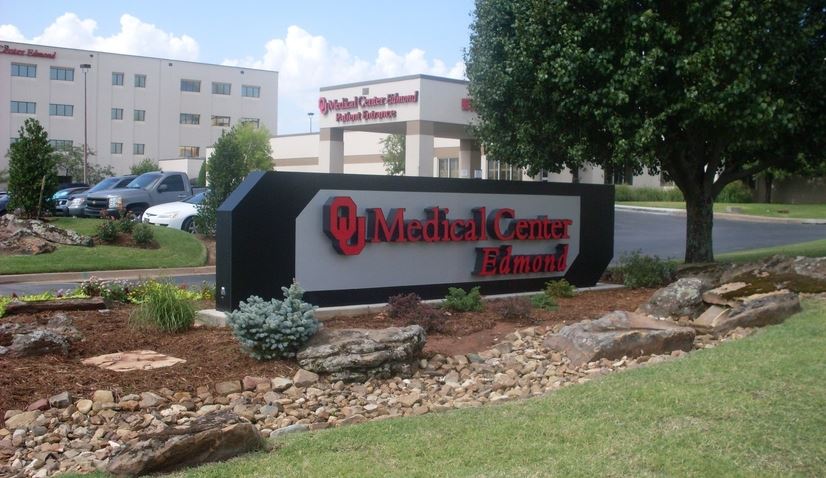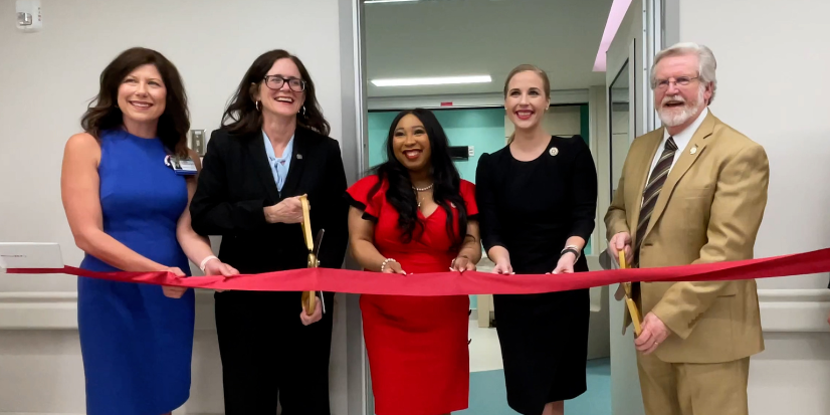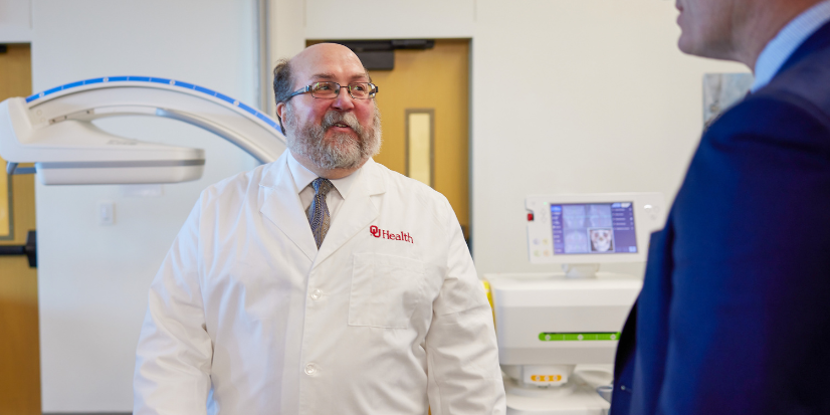OU Health Edmond Medical Center Celebrates 75 Years Serving the Edmond Community
- Category: News, Adults Services
- Posted On:

Located at Second Street and Bryant Avenue, OU Health Edmond Medical Center began serving the Edmond community as Edmond Hospital in February of 1947. Last month, leaders and staff launched a year-long celebration of this impressive 75-year milestone with a variety of internal events and festivities.
Why should any person, especially someone facing a medical emergency, travel beyond the Edmond area to access excellent healthcare, top-flight facilities and expertise that’s second to none? This is the underlying question, spoken or not, that drove civic leaders to establish an Edmond-based hospital to fill a healthcare void, and to grow and succeed in step with the local community.
With her own work history spanning 15 years at Edmond Medical Center, Leslie Buford, chief operating officer, is considered the resident expert on the hospital’s community roots. According to Buford, the hospital’s mission is perpetually driven by another question: “How can we serve not only medical needs, but enrich community life at every level?” The answer lies in what might be called a holistic approach to population health. “The attributes that make Edmond a great place to live, work and raise families include the community’s passion for education, arts and culture. The hospital’s unwavering support of what this community values is the key to mutual growth and ability to thrive.”
Spanning three-quarters of a century, the history of Edmond Medical Center clearly reflects its passion for community, demonstrated by deep engagement in myriad events that promote health and well-being across the lifespan. Scores of activities that promote healthy lifestyles continue to be initiated and/or sponsored by hospital leaders, and enthusiastically supported by employees and staff across work areas and responsibilities.
Edmond’s first hospital offered 22 beds, housed in a vacant space above the Bronco Theater in the Spearman Building at Broadway and Main. Prominent citizens became stockholders and founders of Edmond Hospital and managed its operations for nearly 25 years. Then, as now, the hospital inspired strong community support, as local citizens united to furnish the facility with donated essentials, such as bed and kitchen linens, cooking utensils and more, to launch the mission of locally provided healthcare.
In 1947, the road now known as Broadway Extension was the single strip of pavement connecting Edmond and its 5,000 residents to Oklahoma City. Interstate 35 did not exist, nor was there a turnpike for easy navigation across the miles. It was not uncommon for pregnant women in and around Edmond to give birth at home rather than make the long trek for a hospital delivery. In the midst of a February blizzard, a young pregnant woman began to experience labor pains, and Edmond Hospital opened three days earlier than planned, answering the call to care. Buford told the story shared by a current hospital volunteer, also with strong connections in Edmond and the hospital. “She gave birth to both of her children at the original Edmond Hospital, and one of her memories is the smell of movie popcorn during the delivery.”
Focused Vision
In 1963 and 1964, Edmond’s city council approved an ordinance that created a five-member hospital management board. Members of that first board, John Stone, Chairman; Mike McGough, Vice Chairman; Bob Rudkin, Secretary; Clarance Fledger, member; Burk Thomas, member; were charged with crafting a proposal to acquire a more satisfactory hospital facility. City voters approved the sale of municipal bonds, which raised $400,000 to purchase land and construct a city-owned hospital. Matching federal funds were obtained, and construction began on a 12.5 acre site located at the corner of Second and Bryant.
Buford said people understood what the new hospital would mean to the community, not only for comprehensive care close to home, but for the economic growth and development that were sure to follow. “People had a real vision for Edmond’s future and were eager to sell their land to make way for a larger hospital that would drive all kinds of commercial interests. At the time, this intersection was a rural area surrounded by apple orchards. Today, it is Edmond’s second busiest corner, situated in the heart of the city.”
As the July 1967 opening day neared, the volunteer auxiliary held its first organizational meeting with 54 charter members. Today, Buford works with individuals who have been part of the volunteer auxiliary for 40 years. This dedicated group of volunteers offers day-to-day hospitality, kindness and consideration that has made them legendary. In addition, volunteers unofficially functioned as the hospital’s devoted, if unofficial, historians. “From day one, volunteers began keeping scrapbooks that captured a multitude of hospital events and milestones, internal and external. The bookcase is full of these small pieces of important history spanning 40 years, except for the pandemic pause that began in early 2020.”
The new city-owned facility became Edmond Memorial Hospital, a two-story structure with 35 beds, 50 full- and part-time employees, and eight physicians as active staff.
Growing With Edmond, For Edmond
In November 1971, citizens approved a $1.42 million revenue bond to fund the expansion of the building. A third floor would accommodate immediate needs, with an unfinished fourth floor ready to address future demand. With 13 physicians on active staff, the expansion allowed for 99 licensed beds, plus five intensive care/critical care beds.
By early 1975, active medical staff had increased to 20, and other employees and staff numbered 120. In July 1976, full-time emergency room coverage by physicians expanded from weekends-only to nights and weekends. A year later, the hospital’s board of directors contracted with Hospital Corporation of America (HCA), an independent hospital management firm based in Nashville, Tenn. Edmond Memorial Hospital’s financial position continued to stabilize, showing marked gains for the third and fourth quarters of 1977. For the first time in the hospital’s history, the proposed budget for 1978-79 did not require a subsidy from the city.
In November 1981, the city obtained a Certificate of Need for Phase I expansion to convert the fourth- floor shell into 30 private patient rooms, bathing facilities, a classroom and a number of offices. The plan was approved by the Oklahoma Health Planning Commission in early 1982. The same year, the hospital not only invested nearly $100,000 to purchase new ultrasound equipment, EMH also became one of the first hospitals in the metro area to earn a three-year accreditation from the Joint Commission on Accreditation of Hospitals.
HCA managed the hospital for four years before purchasing Edmond Memorial Hospital from the city in 1981. As a result, the city of Edmond gained $7.2 million, which created a source of funds for municipal reinvestment projects. In a real sense, the hospital became new again, as millions were invested to renovate, expand, purchase sophisticated equipment and provide advanced technologies.
By September 1982, the board sought approval for complete renovation of patient rooms on second and third floors, plus renovation and expansion of all ancillary facilities. The $11 million renovation and expansion was complete in July 1984. The number of active staff members had grown to 90, with 81 on courtesy and consulting staffs.
The hospital continued to grow with the city, and in keeping with the spirit of the original founders, the range of services expanded to meet a wider range of healthcare needs. A local 10-member board of trustees assumed hospital governance. With a workforce of nearly 300, Edmond Memorial Hospital was providing an increasing variety of sophisticated hospital services, more comprehensively meeting the healthcare needs of the community. Specialty practices encompassed medical disciplines from family practice, pediatrics and obstetrics and gynecology, to ophthalmology, orthopedics, surgery, anesthesiology, cardiology, psychiatry, gastroenterology and more.
Edmond Medical Center has been associated with the OU Medical Center since 2010. The resulting infusion of capital funded an array of strategic improvements and the acquisition of equipment needed to meet the healthcare needs in an area experiencing rapid growth.
With its dire global impact, the COVID-19 pandemic presented opportunities for Edmond Medical Center to serve residents throughout the area to minimize COVID-related hospitalizations. Mobilizing for a rapid and effective response to ensure care, the hospital established MAB infusion clinics where therapies were administered on an outpatient basis, avoiding hospitalization to the greatest extent possible. The infusion clinics allowed many patients to recover and regain health in their own homes, also easing the burden on hospital staff and keeping resources available for patients who required inpatient care.
“The challenges of the pandemic were also avenues to gain experience. As the pandemic wanes, we’re well-positioned to continue caring for this community with our sights set on growth to meet the needs of our patient population,” Buford said.
Edmond Medical Center also enriches the community through the services provided at Autumn Life Behavioral Health. The center is the only geriatric psychiatric unit in the OU Health system, and leads the metro area in behavioral health support for individuals age 55 and older. Its programs have been expanded to include an intensive outpatient therapy program, and providers also are seeing outpatient psychiatric patients.
Highly rated by patients for outstanding care, Edmond Physical Therapy employs therapists with decades of experience. Whether patients are recovering from stroke-related impairments and paralysis, to the healing of serious physical injury, these professionals work with each individual to guide patients back to the best quality of life possible.
The hospital actively supports organizations that form the foundation and pillars of Edmond’s civic life. In addition to providing appropriate financial resources and volunteer initiatives, hospital leaders hold seats on numerous committees and boards that guide community investment and development, among them:
- Edmond Public Schools Foundation
- Edmond Mobile Meals
- Edmond Chamber of Commerce
- University of Central Oklahoma
Today, with more than 90,000 residents, Edmond is a vibrant metropolitan neighbor to adjacent counties and communities, including Oklahoma City. Buford said it’s gratifying to see so many areas of growth with direct links to the hospital presence and influence. She ranks the hospital, along with the University of Central Oklahoma, among the most influential corporate citizens of the community. “We have a fantastic partnership with UCO, often co-sponsoring events and activities that promote community life and community health. It’s positive energy that creates its own momentum. Together, EMC and UCO are the pulse of Edmond, serving residents, meeting needs and keeping commerce alive and growing.”
Milestones at a glance:
2001: The hospital opened a 12-bed intensive care unit.
2010: Edmond Medical Center was brought into the OU Medical Center family, operating under the OU license.
2011: The hospital acquired the DaVinci surgical robot, still the only one in Edmond, and opened a new state-of-the-art pharmacy.
2012: After 18 months of demolition and renovation, the hospital opened a completely remodeled third floor.
2013-2014: Renovations throughout the remaining hospital facility were completed to mirror the third floor design, amenities and functionality. As part of this project, bariatric-safe rooms were added on the fourth floor.
2018: A catheter lab with leading-edge services and technologies opened to facilitate treatment and care for cardiac patients.
2019: Technology upgrades to the DaVinci system enabled attending physicians to train the next generation of exceptional providers in robotic surgical techniques.
Planned for this year, orthopedic robotics equipment will advance the care and recovery for patients who have a variety of orthopedic concerns and conditions.
Buford said Edmond Medical Center has a great legacy, but equally important, a future bright with promise. For 75 years, Edmond Medical Center has reaped the benefits of capable and insightful leadership, including Lisa Wilson, M.S., MBA, EMC’s current president who will retire this year.
“One of the greatest attributes of a community hospital – this community hospital – is its warm sense of family,” Buford said. “Nobody wants to make a hospital their literal home, but if you’re here because you require hospital care, you know you’ll receive exceptional care with genuine compassion, close to home.”



